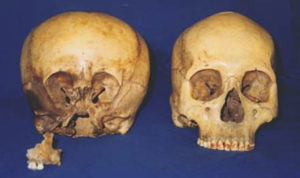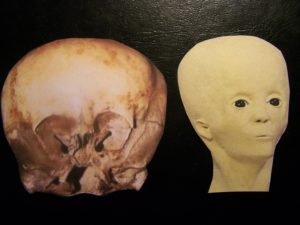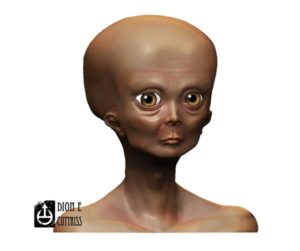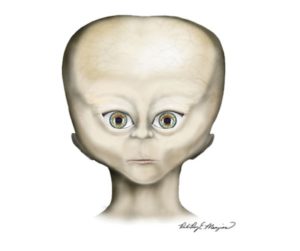Podcast: Play in new window | Download
Subscribe: Apple Podcasts | RSS
 We will examine a curious 900-year-old skull found in Mexico in the 1930s. It appears human-like with a bulging forehead, no brow ridges and a small mouth. At first glance it is otherworldly. Is the skull from an alien or alien/human hybrid or is it from a dwarf or child with an extreme medical condition? We will first look into the history of this skull, we will examine what makes it different from a normal human skull and then we will look into some of the scientific tests done on the skull to determine exactly what we are dealing with.
We will examine a curious 900-year-old skull found in Mexico in the 1930s. It appears human-like with a bulging forehead, no brow ridges and a small mouth. At first glance it is otherworldly. Is the skull from an alien or alien/human hybrid or is it from a dwarf or child with an extreme medical condition? We will first look into the history of this skull, we will examine what makes it different from a normal human skull and then we will look into some of the scientific tests done on the skull to determine exactly what we are dealing with.
So, where did this skull come from? During the 1930s a Mexican-American teenage girl from west Texas was visiting family members in the summer at a small village in the central part of the Mexican state of Chihuahua. Much as we see today, this girl’s family was truly bi-national, living in and visiting different sides of the border during most of the girl’s childhood. In one of those visits the girl went exploring on her own and came across an abandoned mine shaft. Inside the mine tunnel she discovered a human skeleton lying on its back and an arm bone sticking out of the dirt, with the hands of that arm bone wrapped around the upper arm of the exposed skeleton. The girl dug up the buried skeleton which she described as smaller than the exposed one and somewhat deformed. She gathered up all of the bones and hid them nearby. She had the intention of taking them back to the States, but left them in her hiding place until it was time for  her to go back. Between her hiding of the bones and the time of her return to Texas, there had been a flash flood in the area that had washed away most of the bones but had left the two skulls. The misshapen skull was damaged, missing the jaw and most of the teeth. She took what she could back across the border and kept the skulls for the rest of her life. She had them stored in a garage and at one point she applied a varnish or clear shellac to the skulls, probably in an effort to preserve them. The girl – who would die well into her 70s – told the story of the skulls but a few times and could never recall the exact location or the town she had visited at the time of her discovery. Chihuahua is nicknamed El estado más grande, “the largest state”, by Mexicans and its terrain can be inaccessible and difficult to manage. The girl only knew that it was near the Barrancas del Cobre, known to the outside world as Copper Canyon, the largest canyon system in the world, in the remote Sierra Madre Occidental. When the discoverer of the skulls died in the mid-1990s, the skulls passed to friends, and eventually ended up
her to go back. Between her hiding of the bones and the time of her return to Texas, there had been a flash flood in the area that had washed away most of the bones but had left the two skulls. The misshapen skull was damaged, missing the jaw and most of the teeth. She took what she could back across the border and kept the skulls for the rest of her life. She had them stored in a garage and at one point she applied a varnish or clear shellac to the skulls, probably in an effort to preserve them. The girl – who would die well into her 70s – told the story of the skulls but a few times and could never recall the exact location or the town she had visited at the time of her discovery. Chihuahua is nicknamed El estado más grande, “the largest state”, by Mexicans and its terrain can be inaccessible and difficult to manage. The girl only knew that it was near the Barrancas del Cobre, known to the outside world as Copper Canyon, the largest canyon system in the world, in the remote Sierra Madre Occidental. When the discoverer of the skulls died in the mid-1990s, the skulls passed to friends, and eventually ended up  in the hands of Melanie Young, a neonatal nurse from El Paso, Texas in 1998. Nurse Young approached several of her coworkers at the hospital where she worked to try to understand what medical condition could have caused the skull to be so deformed. Not one of her medical colleagues could give Melanie an adequate explanation as to what was responsible for the deformity and she could not rest without answers. That is when she contacted Lloyd Pye, a paranormal researcher who had just published a book titled, Everything You Know is Wrong – Book One: Human Evolution. From this meeting the “Starchild Project” was eventually formed in February of 1999 with Pye as its director.
in the hands of Melanie Young, a neonatal nurse from El Paso, Texas in 1998. Nurse Young approached several of her coworkers at the hospital where she worked to try to understand what medical condition could have caused the skull to be so deformed. Not one of her medical colleagues could give Melanie an adequate explanation as to what was responsible for the deformity and she could not rest without answers. That is when she contacted Lloyd Pye, a paranormal researcher who had just published a book titled, Everything You Know is Wrong – Book One: Human Evolution. From this meeting the “Starchild Project” was eventually formed in February of 1999 with Pye as its director.
After getting assistance from his contacts in various medical fields, Pye began to suspect this Mexican skull had extraterrestrial origins. The initial tests on the skull discovered the basics: it is from a male, and the wear on its teeth would indicate that it is not of a child. The skull dates to around 1100 AD and is contemporary to the Mixtec and Zapotec kingdoms in the south of Mexico and the powerful Toltec Empire which dominated central Mexico at the time.
Lloyd Pye identified 24 distinctive Starchild Skull anomalies which set it apart from a normal human skull (taken from the Starchild Project web site referenced below).
| 1 | The bone is like no other bone on Earth. Its biochemical signature is much richer in collagen than regular bone. |
| 2 | The bone is uniformly half as thick, or less, than normal human bone. It is not thin in a specific area or areas due to abnormality, it is thin all over. |
| 3 | The skull itself weighs half as much as human skulls of comparable size. |
| 4 | The surface of normal human bone is covered with tiny holes called lacunae, which perform the vital function of replacing old bone cells with new ones. The Starchild bone shows virtually no lacunae. |
| 5 | Inside the bone are microscopic “fibers” that may act to reinforce and strengthen the bone. |
| 6 | All bone is like a sandwich with hard cortical bone on the outside and porous cancellous bone that looks like a sponge in the middle. The cancellous bone is where the bone marrow is stored. After death this marrow turns black and is consumed by micro-organisms. The cancellous holes of the 900 year old skull found next to the Starchild are completely empty, however the cancellous holes of the 900 year old Starchild bone contain traces of a red residue. |
| 7 | The lower face of the Starchild Skull is much smaller than a normal human. |
| 8 | It has no brow ridges, which all primates have. Its forehead is smoothly curved straight down to its upper eye sockets, unlike humans or any higher primate. |
| 9 | When a human forehead reaches its upper eye sockets, normally there is a sharp drop down to the pinched-together bones that create the upper nose. In the Starchild there is no drop. The nose extends straight and smooth from the forehead, staying wide and flat until the point where it is broken off, unlike that of humans and all higher primates |
| 10 | The Starchild Skull’s eye sockets are unusually shaped and are only 0.7 inches at maximum depth, compared to normal human eye sockets which average about 2 inches deep. |
| 11 | The optic foramens are the openings in the back of a human eye socket which let in the optic nerve and all the other nerves and blood vessels that “feed” each eyeball and allow it to function. In the Starchild Skull these are shaped and positioned differently. |
| 12 | The Starchild Skull had no frontal sinuses, an extremely rare condition. |
| 13 | All that remains of the Starchild’s lower face is the right side maxilla. The roof of its mouth was flat, lacking any sign of a normal human arch, and like all of the lower face, it is much smaller than that of a normal human. |
| 14 | The Starchild’s zygomatic arches (cheekbones) are broken off, but from the small fragments that remain it is clear that the space between the cheekbones and the other bones of the face is much smaller than it would be in a normal human. This is significant because the chewing muscles for the lower jaw pass through this space, and so must have been much smaller than in a normal human. |
| 15 | Human chewing muscles attach from the lower jaw to the side of the skull, extending over a large area of the skull. The starchild’s chewing muscles The chewing muscles cover only about half as much of the skull. |
| 16 | The Starchild Skull’s ear holes are positioned lower on the head than in a normal human. |
| 17 | The Starchild’s inner ears are approximately twice the size of normal human inner ears. |
| 18 | The Starchild’s neck muscles attach in a way that indicates it was a very small neck relative to typical humans, no more than half of normal size. |
| 19 | Human neck muscles normally attach at an elevated point in the rear center of the occipital bone (the rear bone of the skull). That elevated point is called the “external occipital protuberance,” or “inion” for short. All humans, and indeed all primates on Earth, have an inion. The Starchild Skull does not. |
| 20 | In addition to the external occipital protuberance on the outside of the skull, there is an “internal occipital protuberance” on the inside. This functions like a shelf holding some of the weight of the brain. While the Starchild does have this internal shelf, it is much smaller than it would be in a normal human. |
| 21 | Though the rear of the Starchild Skull is widely expanded and greatly flattened, this is not the result of deliberate binding or cradleboarding. This was verified in 2004 br Dr Ted Robinson and his team. |
| 22 | At the top of the rear of the Starchild’s head is a noticeable “crease” at the rear of its saggital suture, where it meets the lambdoidal suture. The only possible way this can happen in a human skull is if there is abnormal fusion of the saggital suture. A CAT Scan showed that no such abnormal fusion exists in the Starchild Skull. |
| 23 | The Starchild Skull’s physical size is of a small adult in the range of 5 feet tall, or an average 12-year-old, which means its brain should be about 1200 cubic centimeters. An average adult has 1400 c.c. of brain. Instead the Starchild has 1600 c.c. of brain. |
| 24 | The teeth of the Skull are a controversial subject, as many experts feel they show the Starchild was a child of about 5 years old, however the biting surfaces of the teeth are worn and ground to a degree that seems impossible for such a young child, especially one with smaller than normal chewing muscles |
Given these physical anomalies, what of the DNA evidence? The skull has been tested at least 6 times. As it is very expensive to run such tests, a full genome on the skull has not yet been developed. The first test took place at a Canadian lab in 1999. The Starchild Skull Project dismisses the results found at that lab because of carelessness and contamination. The lab was also not equipped to search for ancient DNA and the supposed Y chromosomes discovered, which were not found by the next lab to investigate the skull, were alleged to be from someone who had handled the skull over the years. The second round of DNA tests took place at a California lab called Trace Genetics and those findings showed that the skull had some Native American DNA, consistent with the indigenous tribes of Chihuahua, but there was much of the DNA that was either missing or unexplained.  According to the Starchild Skull Project web site, the skull was then sent to an undisclosed lab with a geneticist doing pro bono work on the skull. This unnamed geneticist had found some DNA in the skull that was conclusively human, but when the data was sent to the National Institutes of Health to find matches with other species, it was found that there was no conclusive match with any known species on earth. Testing on the skull is ongoing and many tests need to be replicated in order to be upheld to rigorous scientific scrutiny.
According to the Starchild Skull Project web site, the skull was then sent to an undisclosed lab with a geneticist doing pro bono work on the skull. This unnamed geneticist had found some DNA in the skull that was conclusively human, but when the data was sent to the National Institutes of Health to find matches with other species, it was found that there was no conclusive match with any known species on earth. Testing on the skull is ongoing and many tests need to be replicated in order to be upheld to rigorous scientific scrutiny.
Scientist and amateur debunkers have come out harshly against the idea that the skull represents tangible evidence of alien visitation, or in the case of the claim of it being an alien-human hybrid, ancient alien genetic manipulation of humans. Debunkers claim that not enough tests have been run and demand that the anonymous geneticist at the secret lab who has been responsible for most of the testing should come forth and be known. Others dismiss anything to do with extraterrestrials out of hand and say that the simplest explanation is often the correct explanation, that the skull belonged to an unfortunate human, a dwarf suffering from massive deformities or a child with a case of Hutchinson-Gilford Syndrome or simple Hydrocephaly.
REFERENCES (not a formal bibliography):
The Starchild Skull – Genetic Enigma or Human Alien Hybrid? by Lloyd Pye.
http://www.starchildproject.com/
http://ancientaliensdebunked.com/a-bone-to-pick-with-the-starchild-skull/

2 thoughts on “The Starchild Skull”
Very interesting would like to learn more
Glad you liked it. You can Google Lloyd Pye’s name and see a whole bunch of stuff about the skull. Pye was probably the most well-known researcher on this skull.